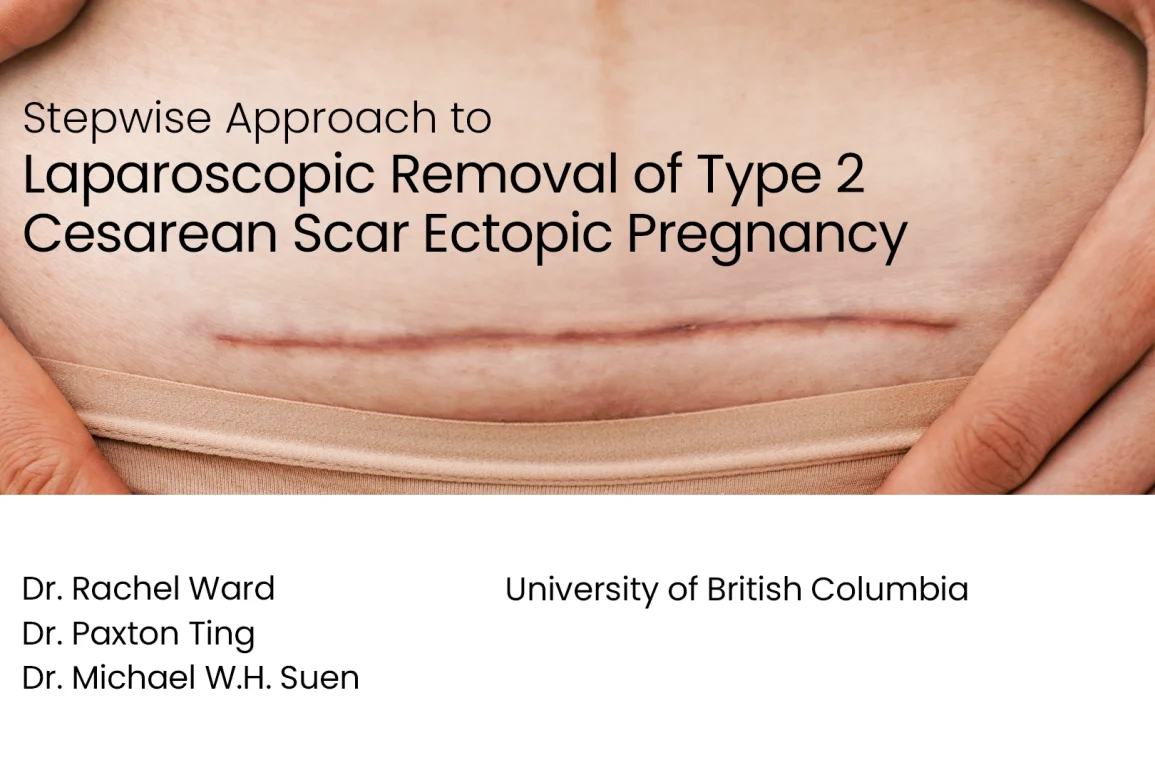Table of Contents
- Procedure Summary
- Authors
- Youtube Video
- What is Laparoscopic Removal of Type 2 Cesarean Scar Ectopic Pregnancy?
- What are the Risks of Laparoscopic Removal of Type 2 Cesarean Scar Ectopic Pregnancy?
- Video Transcript
Video Description
A stepwise laparoscopic approach to removing a type 2 cesarean scar ectopic pregnancy with focus on minimizing risk, blood loss, and preserving fertility.
Presented By



Affiliations
University of British Columbia
Watch on YouTube
Click here to watch this video on YouTube.
What is Laparoscopic Removal of Type 2 Cesarean Scar Ectopic Pregnancy?
Laparoscopic removal of a Type 2 Cesarean Scar Ectopic Pregnancy (CSEP) is a minimally invasive surgical procedure designed to treat a pregnancy implanted deep within the uterine wall at a prior cesarean section scar. This rare and potentially life-threatening condition can lead to uterine rupture and severe bleeding if not promptly managed. Here’s what the procedure involves:
- A Type 2 CSEP occurs when the pregnancy grows outward through a cesarean scar defect into the myometrium and toward the abdominal cavity. Laparoscopic resection is indicated when the pregnancy deeply invades the scar and myometrium, particularly when the overlying uterine wall is thin and at high risk of rupture.
- Preoperative Assessment: Detailed imaging defines gestational sac size and anterior myometrial thickness, both critical risk factors for hemorrhage. Thin myometrium—often less than 1 mm—significantly increases rupture risk and guides surgical planning.
- Stepwise Surgical Technique: The procedure begins with inspection and visualization of the ectopic pregnancy. The vesicouterine peritoneum is carefully incised and dissected to expose the scar. Mechanical hemostasis is achieved by temporary bilateral internal iliac artery clamping, and chemical hemostasis is added with vasopressin injection. The gestational sac and associated isthmocele are then dissected and removed with minimal resection of healthy myometrium.
- Uterine Repair: After removal of the pregnancy and scar tissue, the uterine defect is meticulously closed in two layers using barbed sutures to restore structural integrity and preserve future fertility.
- Multidisciplinary Care: Successful outcomes rely on a skilled team of gynecologic surgeons, anesthesiologists, and perioperative staff experienced in advanced laparoscopy and hemorrhage control.
This approach allows safe removal of the pregnancy while preserving the uterus, reducing blood loss, and supporting future reproductive potential.
What are the Risks of Laparoscopic Removal of Type 2 Cesarean Scar Ectopic Pregnancy?
Although laparoscopic management of Type 2 CSEP offers fertility preservation and less invasive recovery, it remains a high-risk procedure with potential complications:
- Severe Hemorrhage: Abnormal implantation in a thin uterine wall can cause massive bleeding during dissection, sometimes requiring transfusion or conversion to open surgery.
- Injury to Adjacent Structures: The bladder, ureters, and major pelvic vessels are in close proximity and may be injured during retroperitoneal dissection or vascular clamping.
- Anesthetic and Operative Risks: Prolonged surgery, complex vascular control, and patient factors such as high BMI increase the risk of anesthesia complications and intraoperative challenges.
- Infection: Despite minimally invasive techniques, postoperative pelvic or abdominal infections can occur.
- Uterine Rupture in Future Pregnancies: Even with meticulous repair, the uterine scar remains a potential site of weakness, necessitating careful monitoring in subsequent pregnancies.
- Venous Thromboembolism: Lengthy operative times and postoperative immobility elevate the risk of blood clots, requiring prophylactic measures.
With careful preoperative planning, advanced laparoscopic expertise, and vigilant postoperative care, these risks can be significantly mitigated while achieving excellent outcomes for both fertility preservation and patient safety.
Video Transcript:
Stepwise approach to laparoscopic removal of type 2 caesarean scar ectopic pregnancy. The authors have no conflict of interest to disclose. The objectives of this video are to review the definition of a CSEP, describe the indications for laparoscopic resection, and to demonstrate a surgical approach to laparoscopic resection.
CSEP occurs when a pregnancy implants in a myometrial defect caused by dehiscence of the lower uterine segment caesarean scar. Rates are estimated at one in 1,800 to one in 2,500, and incidence increases as caesarean section rates increase. Potential outcomes, particularly if unrecognised, may include catastrophic bleeding, massive transfusion, and emergency hysterectomy.
In this video, we present a case of a 39-year-old G4P3, with three previous caesarean sections and suspected CSEP on her dating ultrasound. Further characterisation demonstrated an overlying myometrial thickness of only 1 mm. This was a wanted pregnancy and she desired fertility in the future.
There are multiple classification systems of CSEP, but no accepted superior method. The earliest, and perhaps most well-known, is that where type 1 describes superficial implantation and growth inwards, whereas type 2 describes deep myometrial implantation and growth outward towards the abdomen.
A recent study, published in obstetrics and gynaecology presents a more granular classification system, whereby both gestational sac size, GS, and anterior myometrial thickness, AMT, are defined as independent risk factors for haemorrhage. The CSEP in our patient with an AMT of less than 1 mm and GS presumed to be between 30 to 50 mm is classified as a type 2 to 3. Previous literature has recommended a laparoscopic approach for CSEP beyond a type 1.
In the case of a CSEP with thin overlying myometrium, we can look at a mathematical formula to appreciate the stress on the thin myometrium. In this formula, the stress, sigma, is equal to the pressure, p, multiplied by the radius, r, divided by two times the thickness, t. Therefore, as the pregnancy develops, the enlarging radius and pressure of the gestational sac combined with a thin, overlying myometrium, such as in our case, exerts increasing stress on the myometrial wall, leading to potential rupture and catastrophic outcomes.
In the video, we present a four-step approach to laparoscopic removal of caesarean scar ectopic pregnancy. Step one, inspection and visualisation of CSEP. Step two, incision and dissection of vesicouterine peritoneum, including mechanical haemostasis with temporary uterine or internal iliac artery clamping, then placement of a uterine manipulator. Finally, chemical haemostasis with vasopressin. Step three, dissect pregnancy and isthmocele. Step four, repair of uterine isthmocele.
The Caesarean scar ectopic pregnancy is easily identified as a bulge just cephalad to the bladder peritoneum. We planned to place bulldog vascular clamps prior to developing the bladder flap, or placing a uterine manipulator to reduce the risk of significant bleeding. We initially started with an anterior approach to dissecting into the retroperitoneum. The paravesical space was developed on the right to attempt to identify the ureter and uterine artery.
Due to the patient’s BMI of 35, with a central distribution and significant vascularity, as expected in a nine-week gravid uterus, the anterior approach was abandoned. However, the internal iliac artery was identified with a tortuous branch of the uterine artery. A lateral approach was then undertaken. Note the previously dissected paravesical space on the right, the round ligament, and the lateral dissection to identify the ureter and internal iliac artery.
The internal iliac artery was isolated and then grasped to facilitate placement of the vascular bulldog clamp. The right ureter was reflected medially as the bulldog clamp was introduced. With the clamp securely in place, attention was turned to the left side. Note the extensive vascularity and nine-week gravid size of the uterus. Again, we started with an anterior approach, dissecting the paravesical space, noting the location of the uterine artery. Again, the adiposity and vascularity made dissection challenging.
We proceeded with a lateral approach to the ureter and internal iliac artery on the left. The artery was isolated with great care and a bulldog clamp was placed without complication. Securing the internal iliac arteries bilaterally provided a mechanical haemostasis prior to introducing a uterine manipulator. In this case, a Valtchev manipulator was used only after the arteries were secured, so as to limit potential haemorrhage.
The vesicouterine peritoneum is now dissected, and the previous development of the paravesical spaces bilaterally facilitated this significantly. There’s minimal tissue left to finish the bladder flap. With the bladder peritoneum dissected, the bulge is even more obvious. The boundaries of the pregnancy are demarcated with an ultrasonic device prior to any distortion of the anatomy. The outer edges of the pregnancy are then infiltrated with vasopressin via a spinal needle transabdominally.
The dissection of the caesarean scar ectopic pregnancy was then initiated. Care was taken in an attempt to follow the spherical gestational sac to avoid resection of normal, healthy myometrium. The overlying myometrium was confirmed to be quite thin, and we encountered the gestational sac quickly. Fluid was suctioned from the gestational sac, and placental tissue was identified and removed. The foetus was then encountered and removed. The footage for this part of the procedure has been intentionally omitted.
A specimen retrieval bag was pre-emptively placed into the abdomen to retrieve tissue. We continued to excise the isthmocele from the surrounding myometrium. The bleeding was extremely minimal due to the mechanical haemostasis with the bulldog clamps and chemical haemostasis with the vasopressin. We did, however, encounter venous bleeding, requiring suturing to obtain haemostasis. There was a total estimated blood loss of only 30 cc throughout the case.
The isthmocele was further dissected from the anterior aspect, again taking care to follow the direction of the isthmocele, rather than a perpendicular wedge that would resect a significant amount of normal myometrium. Inspection of the isthmocele dissection site confirms complete excision. The uterine manipulator helps to clearly define the anterior and posterior walls during closure.
A barbed suture was used to close the hysterotomy in a double layer approach. This patient desired future fertility, and therefore a strong closure of the defect was of utmost importance. The specimen retrieval bag with the pregnancy and the isthmocele tissue was then removed through the 10 mm umbilical port. The bulldog clamps were then taken off bilaterally with great care to not disrupt the internal iliac arteries. Haemostasis was confirmed abdominally at low pressure, as well as vaginally.
In this video, we demonstrated a stepwise approach to laparoscopic removal of a type 2 CSEP. Thank you for watching.


